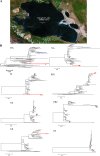Characterization of the H5N1 highly pathogenic avian influenza virus derived from wild pikas in China
- PMID: 19553321
- PMCID: PMC2738197
- DOI: 10.1128/JVI.00793-09
Characterization of the H5N1 highly pathogenic avian influenza virus derived from wild pikas in China
Abstract
The highly pathogenic H5N1 avian influenza virus emerged from China in 1996 and has spread across Eurasia and Africa, with a continuous stream of new cases of human infection appearing since the first large-scale outbreak among migratory birds at Qinghai Lake. The role of wild birds, which are the natural reservoirs for the virus, in the epidemiology of the H5N1 virus has raised great public health concern, but their role in the spread of the virus within the natural ecosystem of free-ranging terrestrial wild mammals remains unclear. In this study, we investigated H5N1 virus infection in wild pikas in an attempt to trace the circulation of the virus. Seroepidemiological surveys confirmed a natural H5N1 virus infection of wild pikas in their native environment. The hemagglutination gene of the H5N1 virus isolated from pikas reveals two distinct evolutionary clades, a mixed/Vietnam H5N1 virus sublineage (MV-like pika virus) and a wild bird Qinghai (QH)-like H5N1 virus sublineage (QH-like pika virus). The amino acid residue (glutamic acid) at position 627 encoded by the PB2 gene of the MV-like pika virus was different from that of the QH-like pika virus; the residue of the MV-like pika virus was the same as that of the goose H5N1 virus (A/GS/Guangdong [GD]/1/96). Further, we discovered that in contrast to the MV-like pika virus, which is nonpathogenic to mice, the QH-like pika virus is highly pathogenic. To mimic the virus infection of pikas, we intranasally inoculated rabbits, a species closely related to pikas, with the H5N1 virus of pika origin. Our findings first demonstrate that wild pikas are mammalian hosts exposed to H5N1 subtype avian influenza viruses in the natural ecosystem and also imply a potential transmission of highly pathogenic avian influenza virus from wild mammals into domestic mammalian hosts and humans.
Figures



Similar articles
-
Distribution of sialic acid receptors and experimental infections with different subtypes of influenza A viruses in Qinghai-Tibet plateau wild pika.Virol J. 2015 Apr 14;12:63. doi: 10.1186/s12985-015-0290-8. Virol J. 2015. PMID: 25880060 Free PMC article.
-
Characterization of a highly pathogenic H5N1 influenza virus derived from bar-headed geese in China.J Gen Virol. 2006 Jul;87(Pt 7):1823-1833. doi: 10.1099/vir.0.81800-0. J Gen Virol. 2006. PMID: 16760384
-
Genetic characterization of H9N2 avian influenza virus in plateau pikas in the Qinghai Lake region of China.Arch Virol. 2017 Apr;162(4):1025-1029. doi: 10.1007/s00705-016-3176-1. Epub 2016 Dec 18. Arch Virol. 2017. PMID: 27990566
-
The genetics of highly pathogenic avian influenza viruses of subtype H5 in Germany, 2006-2020.Transbound Emerg Dis. 2021 May;68(3):1136-1150. doi: 10.1111/tbed.13843. Epub 2020 Sep 29. Transbound Emerg Dis. 2021. PMID: 32964686 Review.
-
The avian and mammalian host range of highly pathogenic avian H5N1 influenza.Virus Res. 2013 Dec 5;178(1):3-11. doi: 10.1016/j.virusres.2013.09.004. Epub 2013 Sep 8. Virus Res. 2013. PMID: 24025480 Free PMC article. Review.
Cited by
-
Five-year longitudinal surveillance reveals the continual circulation of both alpha- and beta-coronaviruses in Plateau and Gansu pikas (Ochotona spp.) at Qinghai Lake, China1.Emerg Microbes Infect. 2024 Dec;13(1):2392693. doi: 10.1080/22221751.2024.2392693. Epub 2024 Aug 24. Emerg Microbes Infect. 2024. PMID: 39137298 Free PMC article.
-
An easy operating pathogen microarray (EOPM) platform for rapid screening of vertebrate pathogens.BMC Infect Dis. 2013 Sep 20;13:437. doi: 10.1186/1471-2334-13-437. BMC Infect Dis. 2013. PMID: 24053492 Free PMC article.
-
Two Prevalent Listeria ivanovii subsp. ivanovii Clonal Strains With Different Virulence Exist in Wild Rodents and Pikas of China.Front Vet Sci. 2020 Feb 26;7:88. doi: 10.3389/fvets.2020.00088. eCollection 2020. Front Vet Sci. 2020. PMID: 32161763 Free PMC article.
-
The modes of evolutionary emergence of primal and late pandemic influenza virus strains from viral reservoir in animals: an interdisciplinary analysis.Influenza Res Treat. 2011;2011:861792. doi: 10.1155/2011/861792. Epub 2011 Nov 15. Influenza Res Treat. 2011. PMID: 23074663 Free PMC article.
-
Characterization of immune responses induced by immunization with the HA DNA vaccines of two antigenically distinctive H5N1 HPAIV isolates.PLoS One. 2012;7(7):e41332. doi: 10.1371/journal.pone.0041332. Epub 2012 Jul 31. PLoS One. 2012. PMID: 22859976 Free PMC article.
References
-
- Chen, H., G. J. Smith, K. S. Li, J. Wang, X. H. Fan, J. M. Rayner, D. Vijaykrishna, J. X. Zhang, L. J. Zhang, C. T. Guo, C. L. Cheung, K. M. Xu, L. Duan, K. Huang, K. Qin, Y. H. Leung, W. L. Wu, H. R. Lu, Y. Chen, N. S. Xia, T. S. Naipospos, K. Y. Yuen, S. S. Hassan, S. Bahri, T. D. Nguyen, R. G. Webster, J. S. Peiris, and Y. Guan. 2006. Establishment of multiple sublineages of H5N1 influenza virus in Asia: implications for pandemic control. Proc. Natl. Acad. Sci. USA 1032845-2850. - PMC - PubMed
-
- Chen, H., G. J. Smith, S. Y. Zhang, K. Qin, J. Wang, K. S. Li, R. G. Webster, J. S. Peiris, and Y. Guan. 2005. Avian flu: H5N1 virus outbreak in migratory waterfowl. Nature 436191-192. - PubMed
-
- Dugan, V. G., R. Chen, D. J. Spiro, N. Sengamalay, J. Zaborsky, E. Ghedin, J. Nolting, D. E. Swayne, J. A. Runstadler, G. M. Happ, D. A. Senne, R. Wang, R. D. Slemons, E. C. Holmes, and J. K. Taubenberger. 2008. The evolutionary genetics and emergence of avian influenza viruses in wild birds. PLoS Pathog. 4e1000076. - PMC - PubMed
Publication types
MeSH terms
Substances
Associated data
- Actions
- Actions
- Actions
- Actions
- Actions
- Actions
- Actions
- Actions
- Actions
- Actions
- Actions
- Actions
- Actions
- Actions
- Actions
- Actions
- Actions
- Actions
- Actions
- Actions
- Actions
- Actions
- Actions
- Actions
- Actions
- Actions
- Actions
- Actions
- Actions
- Actions
- Actions
- Actions
- Actions
- Actions
- Actions
- Actions
- Actions
- Actions
- Actions
- Actions
LinkOut - more resources
Full Text Sources
Medical

